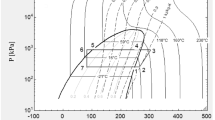Abstract
Research on applying a supercritical carbon dioxide power cycle (S-CO2) to concentrating solar power (CSP) instead of a steam Rankine cycle or an air Brayton cycle has been recently conducted. An S-CO2 system is suitable for CSP owing to its compactness, higher efficiency, and dry-cooling capability. At the Korea Institute of Energy Research (KIER), to implement an S-CO2 system, a 10 kWe class test loop with a turbinealternator-compressor (TAC) using gas foil bearings was developed. A basic sub-kWe class test loop with a highspeed radial type turbo-generator and a test loop with a capability of tens of kWe with an axial type turbogenerator were then developed. To solve the technical bottleneck of S-CO2 turbomachinery, a partial admission nozzle and oil-lubrication bearings were used in the turbogenerators. To experience the closed-power cycle and develop an operational strategy of S-CO2 operated at high pressure, an organic Rankine cycle (ORC) operating test using a refrigerant as the working fluid was conducted owing to its operational capability at relatively lowpressure conditions of approximately 30 to 40 bar. By operating the sub-kWe class test loop using R134a as the working fluid instead of CO2, an average turbine power of 400 W was obtained.
Similar content being viewed by others
References
Dostal V, Driscoll M, Hejzlar P. A supercritical carbon dioxide cycle for next generation nuclear reactors. Massachusetts Institute of Technology, MA 2004, MIT-ANP-TR-100
Wright S A, Radel R F, Vernon M E, Rochau G E, Pickard P S. Operation and analysis of a supercritical CO2 Brayton cycle. SANDIA REPORT, 2010: SAND2010–0171
Pasch J J, Conboy T M, Fleming D D, Rochau G E. Supercritical CO2 recompression Brayton cycle: completed assembly description. SANDIA REPORT, 2012: SAND 2012–9546
Conboy T, Wright S A, Pasch J, Fleming D, Rochau G, Fuller R. Performance characteristics of an operating supercritical CO2 Brayton cycle. ASME Turbo Expo: Turbine Technical Conference & Exposition, 2012, 134(11): GT2012–68415
Conboy T, Pasch J, Fleming D. Control of a supercritical CO2 recompression Brayton cycle demonstration loop. Asme Turbo Expo: Turbine Technical Conference & Exposition, 2013, 135(11): GTP–13–1198
Clementoni E M, Cox T L. Steady-state power operation of a supercritical carbon dioxide Brayton cycle. ASME Turbo Expo: Turbine Technical Conference & Exposition, 2014: GT2014–25336
Clementoni E M, Cox T L. Practical aspects of supercritical carbon dioxide Brayton system testing. Proceedings of the 4th International Symposium-Supercritical CO2 Power Cycles, Pittsburgh, Pennsylvania, 2014
Kalra C J. Development of high efficiency hot gas turbo-expander for optimized CSP supercritical CO2 power block operation. Proceedings of the 4th International Symposium-Supercritical CO2 Power Cycles, Pittsburgh, Pennsylvania, 2014
Moore J, Brun K, Evans N, Bueno P, Kalra C J. Development of a 1 MWe supercritical CO2 Brayton cycle test loop. Proceedings of the 4th International Symposium-Supercritical CO2 Power Cycles, Pittsburgh, Pennsylvania, 2014
Held T J. Initial test results of a megawatt-class supercritical CO2 heat engine. Proceedings of the 4th International Symposium-Supercritical CO2 Power Cycles, Pittsburgh, Pennsylvania, 2014
Zhang Z, Ma Y, Li M, Zhao L. Recent advances of energy recovery expanders in the Transcritical CO2 refrigeration cycle. HVAC & R Research, 2013, 19(4): 376–384
Cho J, Choi M, Baik Y J, Lee G, Ra H S, Kim B, Kim M. Development of the turbomachinery for the supercritical CO2 power cycle. International Journal of Energy Research, 2016, 40(5): 587–599
Cho J, Shin H, Cho J, Ra H S, Roh C, Lee B, Lee G, Baik Y J. Development of the supercritical carbon dioxide power cycle experimental loop with a turbo-generator. Asme Turbo Expo: Turbomachinery Technical Conference & Exposition, 2016: GT2017–64287
Acknowledgments
This work was conducted under the framework of Research and Development Program of the Korea Institute of Energy Research (KIER) (B7-2414). In addition, this work was supported by the On Demand Development Program of Core Technology for Industrial Fields (10063187, Engineering Technique for Power Generation System Design using Industry Waste Heat), funded by the Ministry of Trade, Industry & Energy (MI, Korea).
Author information
Authors and Affiliations
Corresponding author
Rights and permissions
About this article
Cite this article
Cho, J., Shin, H., Cho, J. et al. Preliminary experimental study of a supercritical CO2 power cycle test loop with a high-speed turbo-generator using R134a under similarity conditions. Front. Energy 11, 452–460 (2017). https://doi.org/10.1007/s11708-017-0504-4
Received:
Accepted:
Published:
Issue Date:
DOI: https://doi.org/10.1007/s11708-017-0504-4




